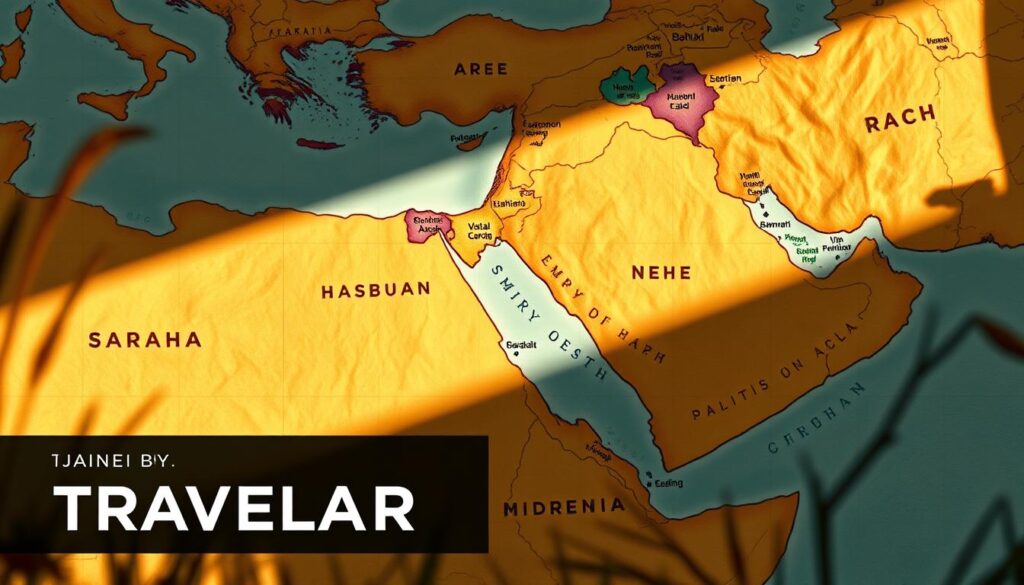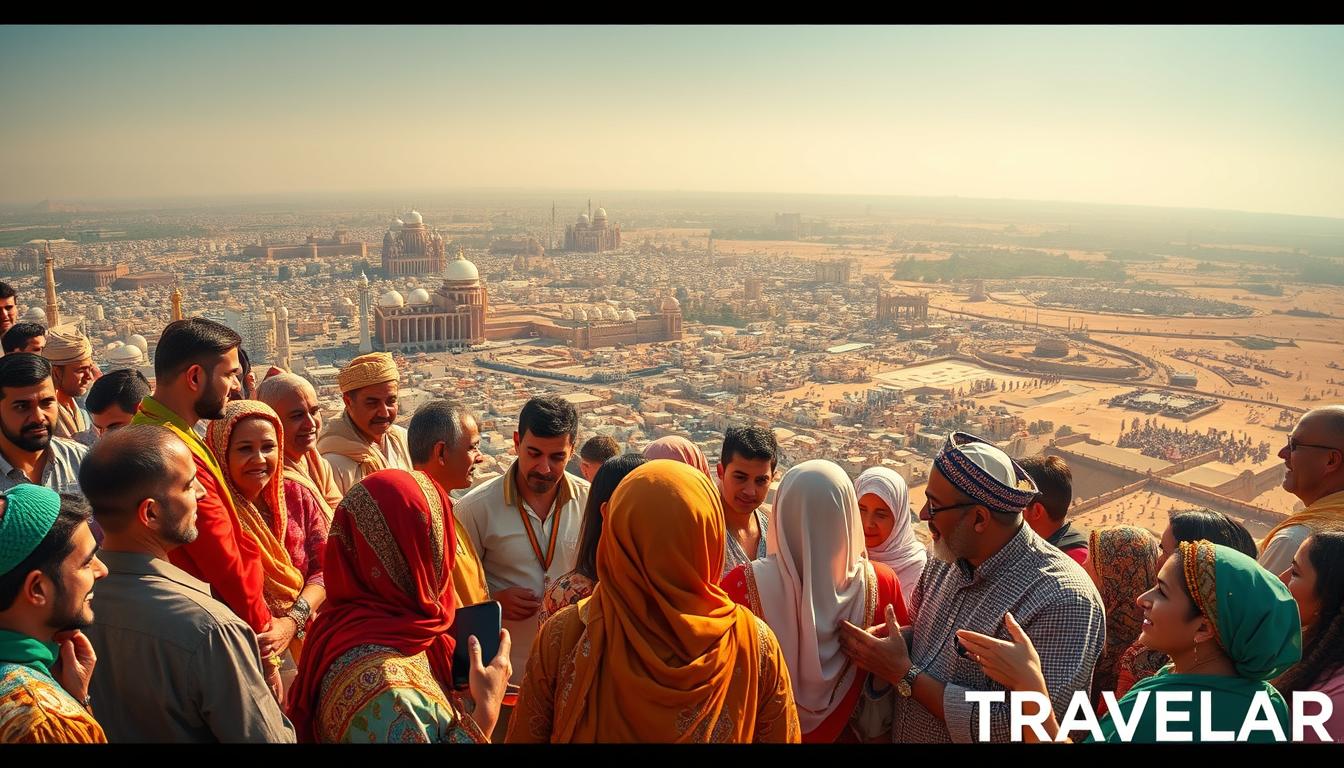Have you ever wondered what makes each Arabic dialect unique? How do they differ in vocabulary, pronunciation, and grammar? Arabic dialect classification is a complex field that shows the language’s diversity. A study with over 30 native Faifi Arabic speakers highlights the importance of understanding these variations.
Arabic dialects are more than just regional differences. They also reflect the culture and history of the Arab world. Studying these dialects offers insights into the language’s evolution and its speakers. As you explore Arabic dialects, you’ll learn about the language’s complexity and how it shapes communication and identity.
Table of Contents
What Are Arabic Dialects?
Exploring the Arab world reveals a rich variety of languages and dialects. Arabic language analysis shows over 20 different dialects, each with its own traits. Understanding these dialects is key to grasping their importance.
Arabic dialects vary by region, influenced by history, culture, and geography. Classification of Arabic languages is complex. For example, the Egyptian dialect is common in Egypt, North Sudan, and parts of Libya. The Levantine dialect is spoken in Lebanon, Syria, Palestine, and Jordan.
Knowing the different dialects is vital. With 22 Arab countries in Africa and Asia, each has its own dialect. This knowledge helps us understand Arabic language analysis better. It also shows how Arabic dialects have evolved and are important in the Arab world.
The Major Arabic Dialect Groups
Exploring Arabic dialects reveals several major groups. The linguistic classification of Arabic dialects is complex. Yet, knowing these groups helps you understand Arabic language varieties. Each group has distinct features.
The five main Arabic dialect groups are: Peninsular, Mesopotamian, Levantine, Egypto-Sudanic, and Maghrebi. Each is shaped by its region’s history, culture, and geography. For example, Maghrebi Arabic has unique vowel shifts and consonant clusters, influenced by Berber and Romance languages.
Some notable dialects include:
- Egyptian Arabic, widely understood due to Egypt’s influence in media and entertainment
- Levantine Arabic, known for its melodic tone and cultural significance
- Gulf Arabic, spoken in the Gulf region and characterized by its distinct pronunciation and vocabulary
- Maghrebi Arabic, spoken in North Africa and influenced by Berber languages and French
Knowing these dialect groups and their traits is key for effective communication. By recognizing each group’s unique features, you can appreciate Arabic’s diversity. This also improves your language skills.
The Impact of Geography on Dialects
Exploring the Arabic language shows how geography shapes its dialects. The Arab region, with over 420 million people, has diverse landscapes. Mountains and deserts have influenced Arabic dialects. Understanding these dialects is key, and machine learning helps a lot.
Geography has led to different dialects in urban and rural areas. For example, Twitter data has 34,905 entries from various regions. Machine learning, like Naive Bayes and logistic regression, has boosted accuracy to 79%.
Geography affects how words are spoken and used. The QADI dataset shows dialect differences in 18 Middle Eastern and North African countries. Traditional methods like SVM and DT are used for dialect classification. But, deep learning models like CNNs and RNNs have made it easier to classify dialects.
Knowing how geography shapes dialects is vital for communication and learning. It helps you appreciate Arabic’s diversity and improve your skills. Machine learning has made language learning and research more efficient and accurate.
Common Features Across Dialects
Exploring Arabic dialects shows us common traits despite their differences. These shared traits come from Arabic’s history, culture, and geography. For example, Egyptian and Levantine dialects share vocabulary and grammar.
Vocabulary variations are a big part of Arabic dialects. While each dialect has its own words, many are shared. This is because Arabic dialects come from a common ancestor. Also, English and French have influenced Arabic, adding to shared vocabulary.
Pronunciation in Arabic dialects also has common traits. For instance, how consonants and vowels are pronounced can differ. Yet, many sounds are the same across dialects. Studies on Arabic dialects show that grammar, like verb forms and sentence structure, is also similar.
Some common traits include:
- Similar vocabulary items, such as words for common objects and concepts
- Shared grammar structures, such as verb conjugations and sentence structures
- Common pronunciation features, such as the pronunciation of certain consonants and vowels
These common traits show the rich history and diversity of Arabic dialects.
Understanding Dialect Continuum
When you dive into the Arabic language, you’ll see a lot of dialectal variation in Arabic across different areas. This isn’t just a thing with Arabic; many languages show similar traits. The idea of dialect continuum is key in Arabic language analysis. It shows how dialects slowly change from one area to another.
The Arabic dialect continuum shows a smooth shift in dialects from one place to another. For instance, the dialects in the Maghreb are different from those in the Arabian Peninsula. This change is not sudden but a gradual one. Each area has its own special dialectal traits.
- Gradual change in dialects across regions
- Unique dialectal features in each region
- Influence of regional languages and cultures on Arabic dialects
Grasping the dialect continuum is vital for good communication in the Arab world. It lets people see the variety in Arabic dialects. This way, they can talk better with folks from different places.
The Role of Media in Dialect Spread
Exploring Arabic dialects shows how media plays a big role. Film, TV, and social media have made some dialects, like Egyptian Arabic, more popular. It’s important to know how media affects our language.
With machine learning, researchers can study how dialects spread. They find patterns in how people talk. This helps us understand language better.

Social media has also changed how we use dialects. People from all over can share their language online. This mix of dialects has created new ways of speaking. For example, some words and sounds are now used more because of social media.
Several things help spread dialects through media:
- Watching TV shows and movies exposes us to different dialects.
- Social media lets people share their language with others.
- Machine learning helps find patterns in dialects.
These factors make Arabic dialects complex and ever-changing. Knowing about regional dialects is key to understanding the language.
Learning Arabic Dialects
Starting your journey to learn Arabic dialects is exciting. It’s key to know the linguistic classification of Arabic dialects and their regional differences. With the right tools and mindset, you can master the dialect you want.
First, pick a dialect to learn, like Egyptian, Levantine, or Gulf Arabic. Each has its own flavor. Knowing these differences is vital for clear communication. Look for language apps, online courses, and language exchange programs that fit your learning style.
Apps like Arab Academy offer self-paced learning and classes for all levels. Listening to Arabic music, watching Arabic movies, and talking to native speakers also helps. These activities make learning fun and practical.
Online language exchange platforms are great for speaking and listening practice. They connect you with native speakers. Consistent practice and exposure are key to mastering any language. By using these resources, you’ll grasp the linguistic classification of Arabic dialects and become fluent in your chosen dialect.
Here are some tips for learning Arabic dialects:
- Start with the basics: Learn the Arabic alphabet, grammar, and common phrases first.
- Immerse yourself in the language: Enjoy Arabic music, watch Arabic movies, and talk to native speakers.
- Practice consistently: Make language learning a daily habit, even if it’s just a few minutes.
Challenges in Dialect Classification
Classifying Arabic dialects is a big challenge. Arabic language analysis shows that dialects differ a lot from Modern Standard Arabic (MSA). This makes it hard for Natural Language Processing (NLP) models to handle.
The overlapping features of dialects make it tricky to set clear boundaries between them.
Several factors make dialect classification tough. These include:
- Sociolinguistic factors, like where speakers are from and their social setting
- Linguistic features, such as words, sounds, and grammar
- The lack of standardization in dialectal Arabic, which hinders the development of precise NLP models
Despite these hurdles, researchers have made big strides. They’ve developed models that can accurately identify Arabic dialects. For instance, transformer models have shown great promise in this area.
Also, datasets like the Shami corpus and the IADD dataset have been created. These resources help researchers train and test their models.
In summary, the challenges in dialect classification show how complex and varied the Arabic language is. More research is needed to improve models for Arabic language analysis and dialectal variation.
Notable Dialectical Differences
Exploring the Arabic language reveals big differences in how people talk. These differences are key to understanding the Arab world. By using machine learning, we can spot these variations, like the Arabic dialects in the Gulf are different from those in the Levant or North Africa.
Words like “water” mean different things in different places. Pronunciation disparities also show up, with unique sounds and rhythms. This is because Arabic has a rich history and is spoken by over 400 million people in 27 countries.

Let’s look at some key points about these differences:
- Vocabulary variations: Different dialects use distinct words and phrases to convey the same meaning.
- Pronunciation differences: Accents and intonations vary across regions, affecting the way words are pronounced.
- Grammar structures: Dialects may have unique grammatical rules and sentence structures.
Understanding these differences helps us grasp the Arabic language better. It also boosts our ability to identify regional dialects. This way, we can use machine learning to improve our communication skills.
The Influence of Other Languages
Exploring Arabic dialects shows how other languages have shaped them. The linguistic classification of Arabic dialects highlights a rich history of language contact. For example, Italian and French have influenced North African dialects. This is clear in the dialect mapping in Arabic, showing the Arab world’s diverse languages.
Colonial history has also played a big role in Arabic dialects. Different areas were ruled by various powers, leading to unique dialects. The Maghrebi Arabic group, for instance, has distinct sounds and spellings. This shows how languages change over time and adapt to new cultures.
- Food-related words like “café” and “pizza”
- Technology terms like “telephone” and “computer”
- Politics and governance phrases like “democracy” and “republic”
These words are now part of Arabic dialects. They reflect the complex history of language and cultural exchange in the Arab world.
Dialects and Identity
Exploring Arabic dialects, you might ask how they tie to identity. The bond between dialects and identity is deep and complex. Dialectal variation in Arabic shapes who we are and where we belong. Arabic language analysis shows dialects mirror our cultural roots and history.
Language connects us to our community and culture. For example, locals use their dialect to show pride in their area. This shows the value of Arabic language analysis in grasping dialects’ role in identity.
Key points about dialects and identity include:
* Cultural significance: Dialects link to cultural traditions and customs.
* Community belonging: Using a dialect shows you belong to a community.
* Personal expression: Dialects let us express our individuality and creativity.
Studying dialectal variation in Arabic and identity deepens our understanding of language and culture. This appreciation helps us value linguistic diversity, including Arabic dialects.
| Dialect | Region | Cultural Significance |
|---|---|---|
| Egyptian Arabic | Egypt | Rich cultural heritage and history |
| Levantine Arabic | Levant | Important role in trade and commerce |
| Gulf Arabic | Persian Gulf | Unique cultural traditions and customs |
Future of Arabic Dialects
As you explore Arabic dialects, you might wonder about their future. Globalization and technology are changing them a lot. Regional dialect identification will grow as people from different places talk more.
Machine learning for Arabic dialects is getting more attention. Researchers are making models to better understand and translate dialects. This tech could change how we talk across languages and cultures.
Deep learning models are being used for dialect identification and translation. For example, the MADAR Arabic Dialect Corpus helps train these models. They can now identify and translate different dialects well.
The table below shows how different models perform on the MADAR Arabic Dialect Corpus:
| Model | BLEU Score |
|---|---|
| GPT3.5 | 29.61 |
| NLLB 3.3B Base | 11.96 |
| AraT5 fine-tuned | 9.41 |
These models perform differently, but they all show great promise. They’re helping shape the future of Arabic dialect identification and translation.
Comparing Arabic Dialects with Other Languages
Exploring the linguistic classification of Arabic dialects shows their unique traits. Arabic dialects belong to the Semitic branch of the Afro-Asiatic family. This family also includes Hebrew and Amharic.
The task of dialect mapping in Arabic is complex. It involves sorting out the many dialects spoken in the Arab world. By studying each dialect’s features, researchers can understand the language’s rich diversity.
Arabic dialects share similarities with other languages. They use consonants and vowels to form words, like Semitic languages do. Their grammatical structures, such as verb conjugation, are also similar.
Yet, Arabic dialects have unique features. For instance, they use diglossia. This means speakers switch between formal and informal language.
Conclusion: Embracing Dialect Diversity
Throughout this journey, you’ve learned about the rich Arabic dialects. Each one, from Egyptian Arabic to Maghrebi Arabic, shows the unique culture and history of its region.
Understanding these dialects helps you talk better with Arabic speakers. It also lets you see the complex beauty of the Arab world. shows us different views, traditions, and lives that make up the Arab identity.
If you love languages, work with Arabic speakers, or just want to learn more, diving into Arabic dialects is rewarding. It brings you closer to the culture and people. Keep exploring and learning about Arabic dialects. You’ll discover the heart of this amazing language.
Source Links
- Subdivisions of Faifi Arabic: a perceptual dialectology approach – Humanities and Social Sciences Communications – https://www.nature.com/articles/s41599-024-03887-5
- Maghrebi Arabic (Darija) – Playaling – https://playaling.com/dialects/maghrebi-darija-arabic/
- Arabic dialects | Understanding the types of Arabic – https://preply.com/en/blog/arabic-dialects/
- Arabic Dialects With Types & Differences To Choose The Right Dialect To Learn – KALIMAH – https://kalimah-center.com/arabic-dialects/
- HOW DIFFERENT ARE ARABIC DIALECTS? – https://www.etoninstitute.com/blog/different-arabic-dialects
- Varieties of Arabic – https://en.wikipedia.org/wiki/Varieties_of_Arabic
- Hierarchical Aggregation of Dialectal Data for Arabic Dialect Identification – https://aclanthology.org/2022.lrec-1.489.pdf
- Enhancing Arabic Dialect Detection on Social Media: A Hybrid Model with an Attention Mechanism – https://www.mdpi.com/2078-2489/15/6/316
- PDF – https://aclanthology.org/2023.arabicnlp-1.63.pdf
- Definiteness Systems and Dialect Classification – https://www.mdpi.com/2226-471X/6/3/128
- PDF – https://aclanthology.org/2023.arabicnlp-1.31.pdf
- Dialect continuum – Citizendium – https://en.citizendium.org/wiki/Dialect_continuum
- Tunisian Arabic – https://en.wikipedia.org/wiki/Tunisian_Arabic
- The Language Continuum (Chapter 1) – Cognitive Control along the Language Continuum – https://www.cambridge.org/core/books/cognitive-control-along-the-language-continuum/language-continuum/EBA345085446B12F1CB6B221451FF3F5
- Advancing arabic dialect detection with hybrid stacked transformer models – https://www.frontiersin.org/journals/human-neuroscience/articles/10.3389/fnhum.2025.1498297/pdf
- Frontiers | Advancing arabic dialect detection with hybrid stacked transformer models – https://www.frontiersin.org/journals/human-neuroscience/articles/10.3389/fnhum.2025.1498297/full
- Arabic Dialects: An Overview of Regional Variations – Arabic Blog – https://earabiclearning.com/blog/2024/08/arabic-dialects-an-overview-of-regional-variations/
- Learn Syrian Arabic – Apps on Google Play – https://play.google.com/store/apps/details?id=com.eyasalhamwi.learn_syrian_arabic
- Quranic Arabic Versus Modern Standard Arabic – Arab Academy – https://www.arabacademy.com/quranic-arabic-vs-modern-standard-arabic/
- Advancing AI-Driven Linguistic Analysis: Developing and Annotating Comprehensive Arabic Dialect Corpora for Gulf Countries and Saudi Arabia – https://www.mdpi.com/2227-7390/12/19/3120
- Advancements and challenges in Arabic sentiment analysis: A decade of methodologies, applications, and resource development – https://pmc.ncbi.nlm.nih.gov/articles/PMC11564071/
- Stance detection in Arabic with a multi-dialectal cross-domain stance corpus – Social Network Analysis and Mining – https://link.springer.com/article/10.1007/s13278-024-01335-5
- Transformer Text Classification Model for Arabic Dialects That Utilizes Inductive Transfer – https://www.mdpi.com/2227-7390/11/24/4960
- QADI: Arabic Dialect Identification in the Wild – https://aclanthology.org/2021.wanlp-1.1.pdf
- What Does an End-to-End Dialect Identification Model Learn About Non-Dialectal Information? – https://www.isca-archive.org/interspeech_2020/chowdhury20_interspeech.pdf
- Arabic(s), Ecologies, Identities… and the Disappearing Rural Vernaculars of Jordan – CBRL – https://www.cbrl.ac.uk/research-blog/arabics-ecologies-identities-and-the-disappearing-rural-vernaculars-of-jordan/
- OSACT 2024 Task 2: Arabic Dialect to MSA Translation – https://aclanthology.org/2024.osact-1.12.pdf
- PDF – https://aclanthology.org/2024.arabicnlp-1.79.pdf
- The Fifth Nuanced Arabic Dialect Identification Shared Task – https://arxiv.org/html/2407.04910v1
- Frontiers | Development and validation of the Arabic children’s strong communication scale: a pilot study – https://www.frontiersin.org/journals/psychology/articles/10.3389/fpsyg.2024.1380296/full
- Frontiers | Arabic or English? Multilingual users’ preferences in Dubai ATM transactions – https://www.frontiersin.org/journals/communication/articles/10.3389/fcomm.2024.1355632/full

